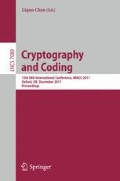Abstract
A self-corrector for a function f is an efficient machine that computes f correctly using any untrusted black-box that computes f correctly only with a certain probability. The design of self-correctors for non-verifiable functions, typically decryption functions of public-key cryptographies, was investigated. We present a design method for self-correctors that works even when the black-box returns correct output with probability of less than 1/2. For a practical demonstration of the method, we also present examples of self-correctors for the decryption functions of public-key cryptosystems, such as the ElGamal, the Pailler, and the GHV cryptosystems, and for hidden pairings with trapdoors.
Access this chapter
Tax calculation will be finalised at checkout
Purchases are for personal use only
Preview
Unable to display preview. Download preview PDF.
References
Arora, S., Lund, C., Motwani, R., Sudan, M., Szegedy, M.: Proof Verification and Intractability of Approximation Problems. Journal of the ACM 45, 501–555 (1992); Preliminary version in FOCS 1992
Arora, S., Safra, S.: Probabilistic Checkable Proofs: A New Characterization of NP. Journal of the ACM 45, 70–122 (1992); Preliminary version in FOCS 1992
Arora, S., Sudan, M.: Improved low degree testing and its applications. In: STOC 1997, pp. 485–495 (1997)
Blum, M., Feldman, P., Micali, S.: Non-interactive zero-knowledge and its applications. In: STOC 1988, pp. 103–112 (1988)
Blum, M., Luby, M., Rubinfeld, R.: Self-Testing/Correcting with Applications to Numerical Problems. In: STOC 1990, pp. 73–83 (1990)
Dent, A.W., Galbraith, S.D.: Hidden Pairings and Trapdoor DDH Groups. In: Dorigo, M., Gambardella, L.M., Birattari, M., Martinoli, A., Poli, R., Stützle, T. (eds.) ANTS 2006. LNCS, vol. 4150, pp. 436–451. Springer, Heidelberg (2006)
Feigenbaum, J., Fortnow, L., Laplante, S., Naik, A.V.: On Coherence, Random-self-reducibility, and Self-correction. Computational Complexity 7(2), 174–191 (1998)
Gemmell, P., Lipton, R., Rubinfeld, R., Sudan, M., Wigderson, A.: Self-testing/correcting for polynomials and for approximate functions. In: STOC 1991, pp. 32–42 (1991)
Gentry, C., Halevi, S., Vaikuntanathan, V.: A Simple BGN-Type Cryptosystem from LWE. In: Gilbert, H. (ed.) EUROCRYPT 2010. LNCS, vol. 6110, pp. 506–522. Springer, Heidelberg (2010)
Goldreich, O., Levin, L.: A Hard-Core Predicate for all One-Way Functions. In: STOC 1989, pp. 25–32 (1989)
Hohenberger, S., Lysyanskaya, A.: How to Securely Outsource Cryptographic Computations. In: Kilian, J. (ed.) TCC 2005. LNCS, vol. 3378, pp. 264–282. Springer, Heidelberg (2005)
Lenstra Jr., H.W.: Factroing Integers with Elliptic Curves. Ann. Math. 126, 649–673 (1987)
Maurer, U.M., Wolf, S.: The Relationship Between Breaking the Diffie-Hellman Protocol and Computing Discrete Logarithms. SIAM Journal of Computing 28, 1689–1721 (1999)
Paillier, P.: Public-Key Cryptosystems Based on Composite Degree Residuosity Classes. In: Stern, J. (ed.) EUROCRYPT 1999. LNCS, vol. 1592, pp. 223–238. Springer, Heidelberg (1999)
Raz, R., Safra, S.: A subconstant error-probability low-degree test, and a subconstant error-probability PCP characterization of NP. In: STOC 1997, pp. 475–484 (1997)
Rubinfeld, R., Sudan, M.: Robust characterizations of polynomials with applications to program testing. SIAM Journal of Computing 25(2), 252–271 (1992); Preliminary version in SODA 1992
Shoup, V.: Lower Bounds for Discrete Logarithms and Related Problems. In: Fumy, W. (ed.) EUROCRYPT 1997. LNCS, vol. 1233, pp. 256–266. Springer, Heidelberg (1997)
Author information
Authors and Affiliations
Editor information
Editors and Affiliations
Rights and permissions
Copyright information
© 2011 Springer-Verlag Berlin Heidelberg
About this paper
Cite this paper
Yamamoto, G., Kobayashi, T. (2011). Self-correctors for Cryptographic Modules. In: Chen, L. (eds) Cryptography and Coding. IMACC 2011. Lecture Notes in Computer Science, vol 7089. Springer, Berlin, Heidelberg. https://doi.org/10.1007/978-3-642-25516-8_9
Download citation
DOI: https://doi.org/10.1007/978-3-642-25516-8_9
Publisher Name: Springer, Berlin, Heidelberg
Print ISBN: 978-3-642-25515-1
Online ISBN: 978-3-642-25516-8
eBook Packages: Computer ScienceComputer Science (R0)

